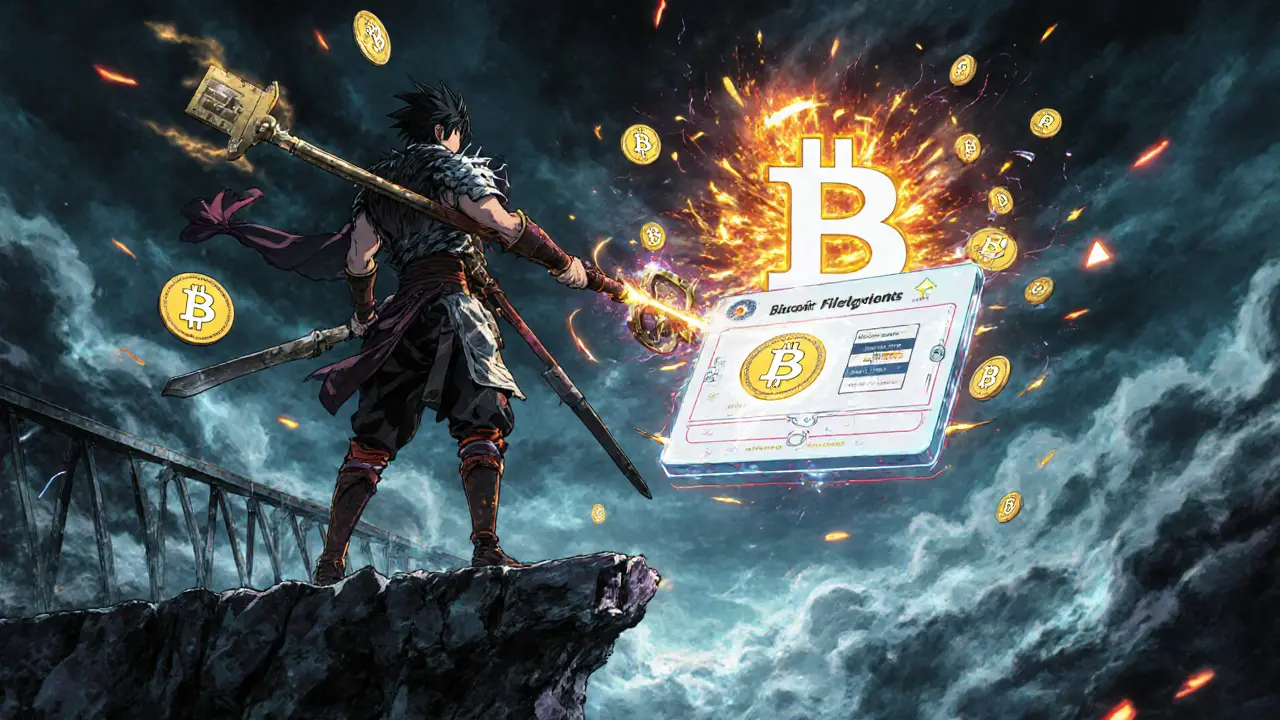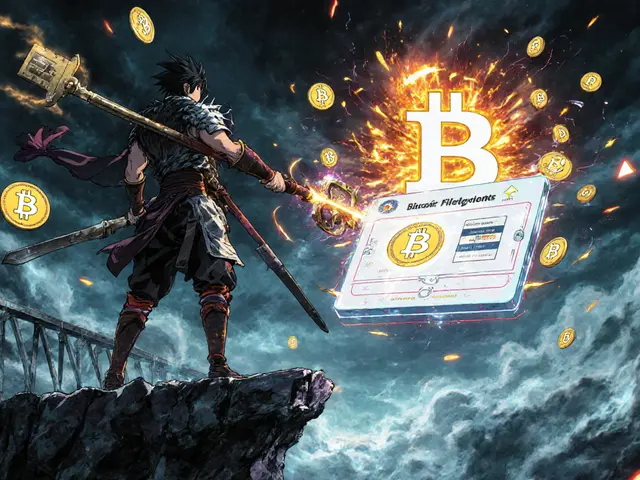Sovryn Margin Trading Calculator
Calculate potential profits or losses when trading Bitcoin on Sovryn with different leverage levels. Understand the risks before using margin trading.
Sovryn Crypto Exchange Review: Bitcoin-Only DeFi Trading in 2025
If you're tired of handing over your Bitcoin to centralized exchanges like Binance or Coinbase, only to wonder if your coins are really safe, Sovryn offers a different path. It doesn't just let you trade Bitcoin - it lets you use your BTC directly for margin trading, lending, and borrowing - without ever giving up control of your keys. No KYC. No deposits to a company wallet. Just you, your Bitcoin, and a sidechain built to make smart contracts work on Bitcoin’s network.
But here’s the catch: Sovryn isn’t for everyone. It’s not a slick app with customer service hotlines or 500 trading pairs. It’s a niche, technical, Bitcoin-native platform that’s growing slowly - and that’s exactly why some traders swear by it.
How Sovryn Works: Bitcoin DeFi, Not Ethereum DeFi
Most DeFi platforms run on Ethereum. Uniswap, Aave, Compound - they all rely on Ethereum’s smart contract power. Sovryn is different. It runs on RSK, a sidechain that connects to Bitcoin. RSK lets Bitcoin handle smart contracts without changing Bitcoin’s core code. That means every trade, loan, or swap on Sovryn gets settled on Bitcoin’s blockchain, benefiting from its 15-year security track record.
When you use Sovryn, you connect your Bitcoin wallet - like Nifty Wallet or Liquality - directly to the platform. Your coins never leave your control. You’re not depositing into an exchange; you’re signing transactions from your own wallet. That’s non-custodial by design. If the Sovryn website goes down tomorrow, you can still access your funds through your wallet. That’s not true for 95% of crypto exchanges.
What You Can Do on Sovryn
Sovryn isn’t just a DEX. It’s a full DeFi suite built for Bitcoin holders:
- Margin Trading: Open leveraged long or short positions using BTC as collateral. Up to 5x leverage is available, with liquidation risks managed by an insurance fund.
- Token Swaps: Trade BTC for other tokens like rBTC, ETH, or USDT - all without leaving the Bitcoin ecosystem.
- Lending & Borrowing: Earn interest by lending BTC or borrow against your holdings. 10% of all interest generated goes into an insurance fund to cover undercollateralized loans.
- Limit Orders: Set price-triggered buy or sell orders for spot trading - a feature added in May 2022 after heavy community demand.
- Sovryn Zero: A trust-minimized borrowing protocol launched in June 2022 that lets you borrow without relying on oracles or centralized price feeds.
The platform doesn’t just add features - it builds them with Bitcoin’s philosophy in mind: permissionless, transparent, and self-sovereign.

The SOV Token: Powering the Ecosystem
Sovryn has its own token: SOV. It’s not on Bitcoin - it’s on Ethereum. Yes, that’s odd. The platform runs on Bitcoin, but its governance and staking token lives on Ethereum. This cross-chain setup is a compromise: Ethereum offers faster, cheaper token transfers, while Bitcoin offers security for the core trading engine.
As of August 2025, SOV trades at around $0.0992 with a circulating supply of 18.27 million out of a max 100 million. Market cap sits at roughly $1.81 million. Trading volume is low - under $55,000 daily - and most trading happens on Gate.io, which reports the highest volume for SOV at $20,775 in 24 hours.
Price predictions are all over the place. WalletInvestor expects SOV to drop to $0.1332 by year-end. PricePrediction.net forecasts it hitting $2.08. TradingBeast is the most bearish, predicting near-zero value by December 2025. The volatility reflects uncertainty: is SOV a utility token with real demand, or just a speculative asset with no clear use case beyond governance?
Pros and Cons: Who Sovryn Is For (and Who It’s Not)
Let’s cut through the noise. Here’s what Sovryn does well - and where it falls short.
Pros
- True Bitcoin sovereignty: Your BTC stays in your wallet. No counterparty risk.
- No KYC: You don’t need to submit ID. Privacy-focused users love this.
- Insurance fund: 10% of interest goes into a safety net for loan defaults - rare in DeFi.
- Open-source and audited: Code is public. Multiple third-party audits completed. Bug bounty program active.
- Limit orders: Automated trading is possible without relying on centralized order books.
Cons
- Low liquidity: With only $55k daily volume, slippage can be high on larger trades.
- RSK gas fees: Fees fluctuate based on network congestion. Peak times can cost more than expected.
- Steeper learning curve: You need to understand wallets, sidechains, and DeFi risk. Beginners get lost.
- No customer support: No live chat, no email helpdesk. You’re on your own.
- Unregulated: Sovryn operates without any government oversight - risky if you’re in a regulated country like the U.S. or EU.
- Small user base: Only 3,244 monthly visits (SimilarWeb, April 2024). Traffic is almost entirely organic - meaning almost no marketing.
If you’re a Bitcoin maximalist who wants to trade BTC without trusting anyone - Sovryn is one of the few options. If you want to trade altcoins quickly or need help when something goes wrong - look elsewhere.
Getting Started: How to Use Sovryn
Here’s how to actually use Sovryn in 2025:
- Get an RSK-compatible wallet. Nifty Wallet or Liquality are the most popular. MetaMask doesn’t work unless you manually add RSK network settings.
- Send BTC to your wallet. Sovryn doesn’t accept direct BTC deposits - you need to convert BTC to rBTC (wrapped Bitcoin on RSK) using the platform’s swap tool.
- Connect your wallet to live.sovryn.app. The interface is clean but minimal.
- Start trading. Use the margin tab to open a position, or go to the swap section to exchange tokens.
- Manage your risk. Keep an eye on your collateral ratio. Liquidation happens fast if BTC drops sharply.
Pro tip: Swap tokens between 1 AM and 8 AM UTC on weekdays. Network congestion is lowest then, and gas fees drop significantly.

Who Uses Sovryn? Real User Feedback
Reddit threads from r/Bitcoin and r/defi in early 2025 show a pattern: users who stick with Sovryn are either hardcore Bitcoiners or DeFi veterans who’ve burned out on Ethereum’s complexity and high fees.
One user wrote: “The limit order feature is the only reason I still use Sovryn. I set it and forget it. But when RSK gets congested, I just wait. No point in paying $15 in gas for a $200 trade.”
Another said: “I love that I don’t have to KYC. But when I tried to borrow USDT, I spent three hours reading docs. I gave up. I’m going back to Celsius.”
The platform’s bounce rate is 50%, and users visit just 1.8 pages per session. That means half the people who land on Sovryn leave because they don’t understand it - or it doesn’t fit their needs.
The Bigger Picture: Is Bitcoin DeFi the Future?
Sovryn is part of a tiny slice of crypto: Bitcoin-native DeFi. While Ethereum DeFi handles over $20 billion in locked value, Bitcoin DeFi is under $200 million - less than 1% of the total. Most developers avoid Bitcoin because it’s not designed for smart contracts. RSK is one of the few attempts to fix that.
Delphi Digital predicts Bitcoin DeFi could grow to 5% of the total DeFi market by 2027 - but only if platforms like Sovryn solve two big problems: liquidity and usability. Right now, Sovryn has neither.
Its roadmap for 2026 includes integrating Sovryn Zero into more features and launching a trust-minimized stablecoin - a move that could be game-changing. If they pull it off, Sovryn might become the backbone of Bitcoin-based lending. If they don’t, it could fade into obscurity, like many early DeFi experiments.
Final Verdict: Worth Trying?
Sovryn isn’t a replacement for Coinbase or Kraken. It’s a tool for a specific kind of trader: someone who values control over convenience, who’s willing to learn, and who believes Bitcoin should do more than just hold value.
If you’re curious, try it with a small amount. Swap $50 worth of BTC to rBTC. Open a 2x leveraged position. See how the interface feels. Learn how gas fees work. If you enjoy it, you might stick with it. If it feels like fighting the system - walk away.
There’s no shame in choosing a centralized exchange. But if you want to prove Bitcoin can do DeFi without Ethereum - Sovryn is the most serious bet you can make.
Is Sovryn safe to use?
Yes, but with caveats. Sovryn is non-custodial, so your funds are never held by the platform. All code is open-source and has been audited by multiple firms. However, the RSK sidechain is less battle-tested than Bitcoin or Ethereum. Smart contract bugs, while unlikely, are still possible. Also, since Sovryn isn’t regulated, there’s no legal recourse if something goes wrong.
Can I trade altcoins on Sovryn?
You can trade a limited selection of tokens - mostly wrapped Bitcoin (rBTC), Ethereum (rETH), and stablecoins like USDT and DAI - all bridged to the RSK chain. You won’t find thousands of altcoins like on Binance or KuCoin. Sovryn’s focus is Bitcoin and Bitcoin-linked assets, not altcoin speculation.
Do I need to do KYC on Sovryn?
No. Sovryn requires zero KYC. You connect your wallet and trade immediately. This makes it attractive for privacy-focused users - but also means it’s not compliant with regulations in countries like the U.S., Canada, or EU member states. Using Sovryn in those regions carries legal risk.
What wallets work with Sovryn?
You need a wallet that supports the RSK network. Nifty Wallet and Liquality are the most reliable. MetaMask can be configured manually by adding RSK’s network parameters, but it’s not officially supported. Avoid using exchange wallets (like Binance or Coinbase) - they don’t support RSK.
How do I get SOV tokens?
SOV tokens are available on a few exchanges, primarily Gate.io. You can also earn them by providing liquidity on Sovryn’s trading pools. Staking SOV gives you a share of platform fees, but the returns are low due to small trading volume. Don’t buy SOV expecting quick gains - it’s a long-term bet on Bitcoin DeFi.
Is Sovryn better than Uniswap or dYdX?
Only if you’re using Bitcoin as your base asset. Uniswap and dYdX offer higher liquidity, more tokens, and better user experience - but they’re built on Ethereum. Sovryn gives you Bitcoin-native DeFi with no middleman. If you’re holding BTC and want to trade it without selling, Sovryn is unique. Otherwise, Uniswap is easier and faster.
What’s the future of Sovryn?
Sovryn’s future hinges on two things: launching a Bitcoin-based stablecoin and improving usability. If they succeed, they could become the go-to platform for Bitcoin DeFi. If they fail to attract more users or liquidity, they’ll remain a niche experiment. The team is small but technically strong. The market, however, is moving fast - and Sovryn is still a tiny player.








